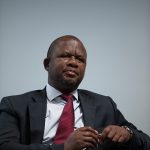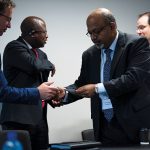
The African Development Bank (AfDB) estimates an unmet demand for bank-intermediated trade finance in Africa of between US$110bn and US$120bn. GTR gathered a group of the continent’s trade leaders to talk about the consequences, the role of regulation and the innovation that Africa needs to address the issue.
Roundtable participants
- Michael Dean, managing director, head of trade and specialty finance, White Oak Trade and Specialty Finance
- Sean Edwards, head of legal, SMBCE and chair, International Trade & Forfaiting Association
- Minos Gerakaris, head of trade finance, Rand Merchant Bank (RMB)
- Laurie Hammond, partner, Hogan Lovells South Africa
- Vinod Madhavan, head of trade, Standard Bank
- Sekete Mokgehle, head of global commodity finance, Nedbank CIB
- Duarte Pedreira, board member, International Trade & Forfaiting Association and head of trade finance, Crown Agents Bank (chair)
- George Wilson, head of Africa trade financial institutions, Absa
Pedreira: What do you think is really behind Africa’s trade finance gap, and can you share with us an example of a transaction that was left undone, and why?
Gerakaris: The gap is a reality. However, with the constant change in regulation, compliance, cost of capital and so on, the split between what is bankable and what is not bankable is, sadly, growing.
We have had to turn away some really nice transactions in East Africa, particularly where we have moved beyond only trying to bank large traders in the region and looked to domestic corporates, which have historically been family-owned.
Among these companies there has been a reticence to disclose financials with their banks and to appoint a larger, recognised audit firm. Typically, convoluted ownership structures exist, with a number of related parties in a transaction. The return on effort to get that transaction over the line for a relatively small ticket can become unpalatable for a bank.
There has been a pull towards easier execution: rather doing a very large ticket deal for a trader without the burden of having to take and register cession of rights against properties, for example. It is not what everyone wants to hear, but it is a reality in our world.
Pedreira: The obvious thing to me is that we will all be doing the same deals over and over again. Are we creating systemic risk in the banking sector again by piling in to the same transactions? If one of the large traders folds, we are all in trouble, aren’t we?
Madhavan: Yes. I think we could be in trouble, and it could be coming anytime.
It is true that a bankable corporate is bankable for all of us. And hence, all of us would actually be happy to take more exposure on the same cohort of clients. In South Africa, Steinhoff, which caught all of us by surprise, proves your point. The prudent risk management approach is to try and diversify.
However, as Minos has said, when you start diversifying, either you go into a market like Kenya and you start writing a family-owned business, or you want to go into Botswana and support local beneficiation, which means that your normal models don’t apply.
Dean: I’m the outlier in the room in terms of providing capital. Our strategy is really to try and work with banks and funding platforms. One reason is efficiency. The ability to underwrite, execute and eventually close on an individual deal can be cumbersome and time-consuming. It’s more efficient for us to work with partners that have a physical presence in each of the local markets that we cover.
The second reason is scale, and this goes to the funding gap question. If we are really going to make a difference in addressing the trade finance gap over the near term, we have to have a broader strategy that can allow us to deploy at scale. We have to figure out how we can engage with partners, bring capacity to the market and make the best use of both time and available capital.
For us it’s a case of identifying who the right players are and how we can work with these partners to best execute and deploy.
Pedreira: One of the interesting things that development banks such as Afreximbank are doing is creating a sort of compliance repository. I think that is part of the solution. When you are onboarding an SME to the supply chain and invoice discounting platforms in the OECD markets, why does it work? Simply because you just onboard the counterparty, and that’s it. Not many questions are asked, because these companies tick all the boxes. If you want to implement that sort of solution in Africa, the only way for that to work is by creating two mechanisms: one, to assess the counterparty from a compliance point of view and give them some sort of risk rating at onboarding, and the other one is in terms of the creditworthiness.
There is another element to this. According to surveys, one of the biggest obstacles that people keep mentioning is that it is hard to structure in Africa in particular. You have different legal systems. Is it really that hard to structure in emerging markets?
Hammond: I don’t think it is. We do it every day. It does maybe take more time, and it’s doing that due diligence beforehand: knowing who your counterparty is and what assets you require security over. Deals that are small can be as difficult and as complex to implement as a large US$100mn deal. This is often the issue: on a short-term view, these deals have a relatively high cost to implement. But if banks and other funders look at SMEs with a longer-term view, they could identify potential and then, in the longer term, that upfront relatively high investment can end up being a valuable relationship and plugging that gap. We will always support our clients in building these relationships.
Gerakaris: You have to pick the right counterparty, then invest time to take them through why you need a 90-page LMA document, when before they have simply signed a one-page loan agreement. As the sophistication of these businesses grow, there is also an element of training required. It is a significant investment, but it is about broadening that base and opening a portfolio of up-and-coming clients.
Mokgehle: The one thing the industry could embrace which may lead to easier structuring is collaboration. There’s a lot of knowledge that sits with legal firms that have done the structures. But when do we involve them? When the deal is done. If you involve them earlier on, they could suggest ways to mitigate because they have seen the pitfalls. Collaboration could assist the key stakeholders to understand the flow in order to provide a solution using past experience.
Gerakaris: As a market we are collaborating far more on transactions. In the past, it was easier for us to go to Europe to try and find a syndication partner than crossing the road here in Johannesburg to speak to the other South African banks.
Madhavan: Laurie, why do we reinvent the document every time? The underlying structure is still the same. Is it possible to come out with an equivalent in whatever we do?
Hammond: The issue is usually the underlying assets being secured. There are different assets in different countries, and that is where the complexity lies. They are never the same in any deal.
Edwards: The counterweight to this, as a banker told me recently, is that many banks don’t want highly structured deals. They want plain vanilla that they can get through their credit committee very quickly, and which they know that they can sell as well. It is a chicken and egg scenario: the funds and the alternative investors want to know what they are buying. The simpler it is, the more likely they are to pick it up.
That is why, for example, at the International Trade and Forfaiting Association (ITFA) we’re very interested in producing digital promissory notes: it’s a very easy legal instrument to understand.
There is always a bit of an adoption period, where you have to understand something, but the simpler it is, the more likely it is to be created, bought, and ultimately sold and distributed into the secondary market.
Wilson: Yes, there is a structuring issue and yes, there is a shortfall particularly in that SME space that probably doesn’t justify a 90-page LMA documentation. But there is a middle way and it kind of behoves us as banks, and probably the South African banks in particular, to use that innovative banking technology to package together all of those unmet flows that are too small, cumbersome and dynamic for international investors. Our role, reaching into Africa, is also to fund the banks that are financing the SMEs in the African countries.
Pedreira: Isn’t it about empowering people on the ground to be able to deliver these structures in a more effective way?
Edwards: People need education all the time, whether it is Africa, Europe, Asia or the US. The real benefit of education in Africa is to understand some of those simple concepts, such as avalised promissory notes, which SMBC is now starting to do in Kenya, partly because the creditworthiness of the local Kenyan banks is better than what it used to be. But it’s also about understanding some of the newer risk-mitigating structures: it all starts with education, and ITFA is making a great start with that.
Pedreira: It is also about helping people become bankable. One example is of a bank in Sierra Leone that had undergone KYCC by us, and we had two or three guys from client due diligence doing an audit and producing a report, and the number of items on the remediation that they had to go through was scary. Do you know what they did? They hired 100 temporary staff to make their account opening forms good. Those guys, from being not completely unbankable, but close to it, three months later, were at top standards by anyone’s account. They had top systems for screening and checking, they had the procedures in place, they beefed up the compliance team and so on. So the question I ask is, as partners, collectively, how much are we doing for our clients on the ground, particularly the FIs, in terms of helping them overcome those compliance issues?
Hammond: There is a role for lawyers there too. We have been approached to help with some central bank training on exactly that point: we go in and help them get their procedures and compliance manuals in order. They can then train their commercial banks.
Pedreira: There is another angle there, which is the derisking issue. I don’t want to delve into the details of whether derisking is risk-based or profitability-based, but I think people are tending to lean towards the latter now. But the derisking exercise is also obviously leaving a void in the market. As a result, rather than growing empowerment, we are reducing it.
Wilson: It is not clear to me that international banks should be expending the cost of trying to KYC and onboard African banks and African corporates when we have four or more South African banks who have all that infrastructure on the ground.
Madhavan: Looking at the whole compliance piece, in a strange way, the fact that we don’t do dollar clearing has actually helped us. The moment you get into that space, it creates a totally different degree of compliance standards. Standard Bank goes down the route of subsidiarisation: each of our local legal entities are governed by the local law. The central bank of Nigeria is a top customer for us, whereas an American bank might view the same customer in a different light.
The trade finance gap and its filling is more dependent on our ability to take credit risk and less on compliance. My answer would have been different if you had asked me two years back.
Gerakaris: This is probably an unpopular opinion, but what the derisking has forced some countries to do is re-evaluate whether smaller markets need as many as 50 banks. In certain markets, it periodically becomes an election issue: shall we increase bank minimum capital to force consolidation and face fierce lobbying against this? Nigeria is a good case study: it went from 96 banks to 20 banks. This is exactly what that market needed; the reduction in bank numbers brought stability and large sound banks. Do relatively small East African markets need 50, 60 or 70 banks which are often family-aligned and effectively just a treasury operation? All those banks are trying to bank the same few corporates.
In my view, what is needed is consolidation in those markets. In South Africa, and other markets, there are a few large players who bank holistically from the lowest retail customer to the largest multinational, and there is space within each organisation to do that, because the infrastructure is in place to cover the complex regulations and compliance requirements. Four or five large banks is probably the maximum these markets should have, without of course taking into consideration niche investment banks for specialised business.
Pedreira: How much is technology part of the solution?
Madhavan: There is a need for fintech in risk distribution: CCRManager is one player that allows you to expose your need to multiple players through an online marketplace. I feel that is something that will really move the needle as far as meeting the client need.
Trying to go against blockchain is not an option: we have to invest resources. We have to see who will be left standing and be open to working with whoever is left standing to realise the operational efficiencies.
Gerakaris: You need to open your APIs to have linkages with fintechs and other alternative providers and build an ecosystem that is enabling.
Mokgehle: I know liquidity is not a problem, but I don’t know whether technology will help the industry with changing the risk profile mentality. Where I see technology playing a role is in the inefficiencies of doing things – things which currently present a bottleneck and prevent a fast turnaround time.


















